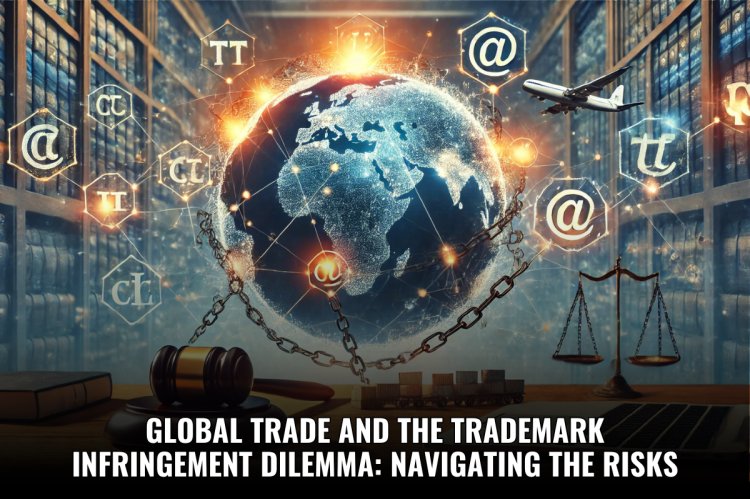Global Trade and the Trademark Infringement Dilemma: Navigating the Risks
In an era where international trade is booming, businesses are expanding their reach beyond borders. While this presents immense opportunities, it also brings challenges, one of the biggest being trademark infringement. Companies often find themselves entangled in legal disputes when counterfeit goods, unauthorized branding, and intellectual property theft emerge across global markets. This article explores how global trade contributes to trademark infringement, its impact on businesses, and potential strategies to mitigate risks.

The Global Marketplace: A Blessing and a Curse
The world has never been more connected than it is today. Thanks to technological advancements and free trade agreements, businesses can seamlessly sell their products to customers thousands of miles away. While this is fantastic for economic growth, there’s a hidden downside: trademark infringement.
When companies expand globally, they often face a reality check, somewhere, someone might be using their brand name, logo, or product likeness without permission. Whether it’s an intentional knockoff or an innocent oversight, the consequences can be damaging.
The Role of Global Trade in Trademark Infringement
1. The Rise of Counterfeit Goods
One of the biggest culprits behind trademark infringement in global trade is counterfeiting. Countries with loose intellectual property regulations—think parts of China, India, and Southeast Asia—have become hotspots for counterfeit production. Luxury brands like Louis Vuitton and Nike constantly battle against knockoffs flooding the market, often sold through online platforms or at local markets.
These counterfeit goods not only deceive consumers but also harm businesses in multiple ways:
- Loss of revenue
- Damage to brand reputation
- Safety risks (especially in pharmaceuticals and electronics)
For example, imagine buying a “Gucci” bag online, only to receive a cheap replica. Not only does this erode trust in the brand, but it also leads to legal complications when businesses try to take action.
To know more about this you can follow the link below:
2. Parallel Imports and Grey Markets
Parallel imports—also known as the grey market—refer to genuine products being sold in unauthorized markets. This occurs when a product intended for sale in one country is imported and sold in another without the brand owner’s consent. For instance, a skincare brand selling products in Europe at a lower price might find the same products being resold in the U.S. at a cheaper rate, undermining its pricing strategy. Though not necessarily illegal, parallel imports can cause brand confusion and revenue loss.
3. Lack of Harmonized Trademark Laws
Trademark laws vary significantly from country to country. A business may have exclusive rights to a brand name in one country but find that the same name is already registered by another company elsewhere. This leads to lengthy legal battles, as seen in Apple’s struggle with the iPhone trademark in Brazil, where a local company owned rights to the name before Apple even entered the market. In some cases, companies are forced to rebrand in certain markets just to avoid conflicts. Think of Burger King, which operates as “Hungry Jack’s” in Australia due to trademark restrictions.
4. E-Commerce and Online Marketplaces
The internet has revolutionized trade, but it has also opened the floodgates for trademark infringement. Online marketplaces like Amazon, Alibaba, and eBay are rife with sellers offering counterfeit or unauthorized products under well-known brand names. Despite efforts to police these platforms, enforcement remains a game of whack-a-mole—take one infringer down, and another pops up. Additionally, with the rise of drop-shipping, businesses often source products from third-party suppliers without verifying authenticity, inadvertently contributing to infringement issues.
The Impact on Businesses
The effects of trademark infringement in global trade are far-reaching. For small businesses, these risks can be devastating, making it crucial to proactively protect their intellectual property.
- Financial Losses: Legal battles, lost sales, and damage control efforts can be costly.
- Reputational Harm: A brand’s image can suffer if consumers unknowingly purchase inferior counterfeit products.
- Legal Complexities: Navigating trademark laws across different jurisdictions can be overwhelming and expensive.
- Consumer Safety Risks: Fake pharmaceuticals, electronics, and even food products can pose serious health hazards.
How Businesses Can Protect Their Trademarks
1. Register Trademarks in Key Markets
A common mistake businesses make is assuming that a trademark registered in one country applies globally. Registering in key markets—especially where counterfeiting is prevalent—helps establish legal grounds for enforcement.
2. Monitor Online and Offline Markets
Regularly scanning e-commerce platforms, marketplaces, and social media for counterfeit or unauthorized use of trademarks can help businesses take swift action.
3. Work with Customs Authorities
Many countries allow businesses to work with customs officials to prevent counterfeit products from entering their markets. For example, in the U.S., companies can record their trademarks with Customs and Border Protection (CBP) to intercept fake goods at ports.
4. Implement Strong Contracts with Distributors
Ensuring clear contractual agreements with international distributors can help prevent parallel imports and unauthorized reselling.
5. Leverage Technology for Brand Protection
AI-powered brand protection tools can help identify counterfeit listings, unauthorized sellers, and trademark misuse across the web, allowing businesses to take action swiftly.
6. Take Legal Action When Necessary
While litigation is costly, taking legal action against repeat offenders sends a strong message and can deter further infringement.
Conclusion
Global trade is a double-edged sword—it presents tremendous growth opportunities but also opens the door for trademark infringement risks. As businesses expand internationally, understanding the landscape of intellectual property laws and taking proactive measures to protect their trademarks is essential.
From counterfeit goods to legal battles over brand names, trademark infringement in global trade isn’t going away anytime soon. However, with the right strategies in place—such as registering trademarks globally, monitoring markets, and working with authorities—businesses can navigate these challenges and safeguard their brands. Ultimately, the key is vigilance. In today’s fast-moving, interconnected world, protecting a brand requires more than just a legal trademark—it demands constant awareness and action.












